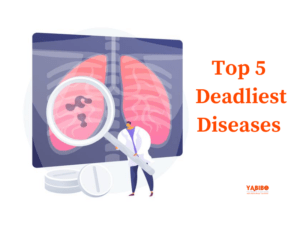The deadliest diseases in history are life-threatening and need to be treated immediately. People across the world do like to know more about the top five deadliest infectious diseases.
The deadliest diseases in history have been recorded and even today are of much concern.
It is worth knowing more about the top 5 deadliest infectious diseases.
Table of Contents
1. Coronavirus Disease (COVID-19)
Coronavirus disease (COVID-19) happens to be an infectious disease caused by a newly discovered coronavirus.
Most people infected with the COVID-19 virus experience mild to moderate respiratory illness and recover without requiring special treatment. Older people and those with underlying medical problems such as cardiovascular disease, diabetes, chronic respiratory disease, and cancer can be seriously affected.
Prevention Tips for Covid-19
- Wash the hands regularly with soap and water, or clean them with alcohol-based hand rub.
- Maintain at least 1-meter distance between oneself and people coughing or sneezing.
- Avoid touching the face.
- Cover the mouth and nose when coughing or sneezing.
- Stay home if a person feels unwell.
- Refrain from smoking and other activities that tend to the lungs.
- Practice physical distancing by avoiding unnecessary travel and also stay away from large groups of people.
Symptoms of Coronavirus
Most common symptoms:
- fever
- tiredness
- dry cough
Less common symptoms:
- aches and pains.
- sore throat
- conjunctivitis
- diarrhea
- headache
- loss of taste or smell
- a rash on the skin, or discoloration of fingers or toes
Serious symptoms:
- difficulty breathing or shortness of breath.
- loss of speech or movement.
- chest pain or pressure.
2. Ischemic Heart Disease
The first and the most fatal disease in the world happens to be Ischemic Heart Disease. It is also known as coronary artery disease (CAD). When the blood vessels that transmit the blood to the heart are contracted then coronary artery disease occurs. If not examined at an early stage, then the patient suffers from heart failure, chest pain, and an irregular heartbeat known as arrhythmias.
Risk Factors of CAD
- Obesity or overweight
- Cholesterol
- High blood pressure
- Smoking and drinking
- Diabetes
- Genetic or family history of CAD
Prevention of CAD
- Exercise regularly
- Stay away from smoking and drinking
- Eat healthy food
- Stay away from smoking and drinking
- Low sodium diet
3. Stroke
When an artery is blocked or leaking in the brain then a stroke occurs. This leads to oxygen-deprived cells dying within seconds. When a stroke occurs, the body goes numb, and the affected person cannot walk nor see properly. If neglected it can cause lasting disability.
Risk Factors of Stroke
- Smoking
- High blood pressure
- Having a family history
- High cholesterol
- Overweight
- Heart diseases
Prevention of Stroke
- Eating a healthy and balanced diet
- Maintain proper weight
- Being active and working out
- Quit Smoking
- Maintain proper weight
- Get clinical trials every year
- Take necessary medications Get the vaccine
4. Lower respiratory infections
A lower respiratory infection is an infection in one’s airways and lungs.
Causes of Respiratory infections
- influenza, or the flu
- bronchitis
- pneumonia
- tuberculosis
Viruses usually cause lower respiratory infections to occur due to bacteria. Coughing is the main symptom. Other symptoms are breathlessness, wheezing, and a tight feeling in the chest. If untreated, it can cause breathing failure or death.

Risk factors and prevention
Risk factors for lower respiratory infection include:
- the flu
- a weak immune system
- poor air quality or frequent exposure to lung irritants
- smoking
- crowded childcare settings, which mainly affects infants
- asthma
- HIV
5. Trachea, bronchus, and lung cancers
Respiratory cancers do include cancers of the trachea, larynx, bronchus, as well as lungs. The main causes are smoking, secondhand smoke, as well as environmental toxins. Of course, household pollutions such as fuels and mold do contribute.
Risk factors and prevention
Trachea, bronchus, and lung cancers can affect any person, but those with a history of smoking or tobacco use are more prone to it. Other risk factors are family history and exposure to environmental factors, such as diesel fumes.
Apart from avoiding fumes and tobacco products, nothing else can be done to prevent lung cancers. Yet, early detection helps improve outlook and reduces symptoms of respiratory cancer.
Conclusion
These deadliest diseases in history are of much concern to people across the world.

